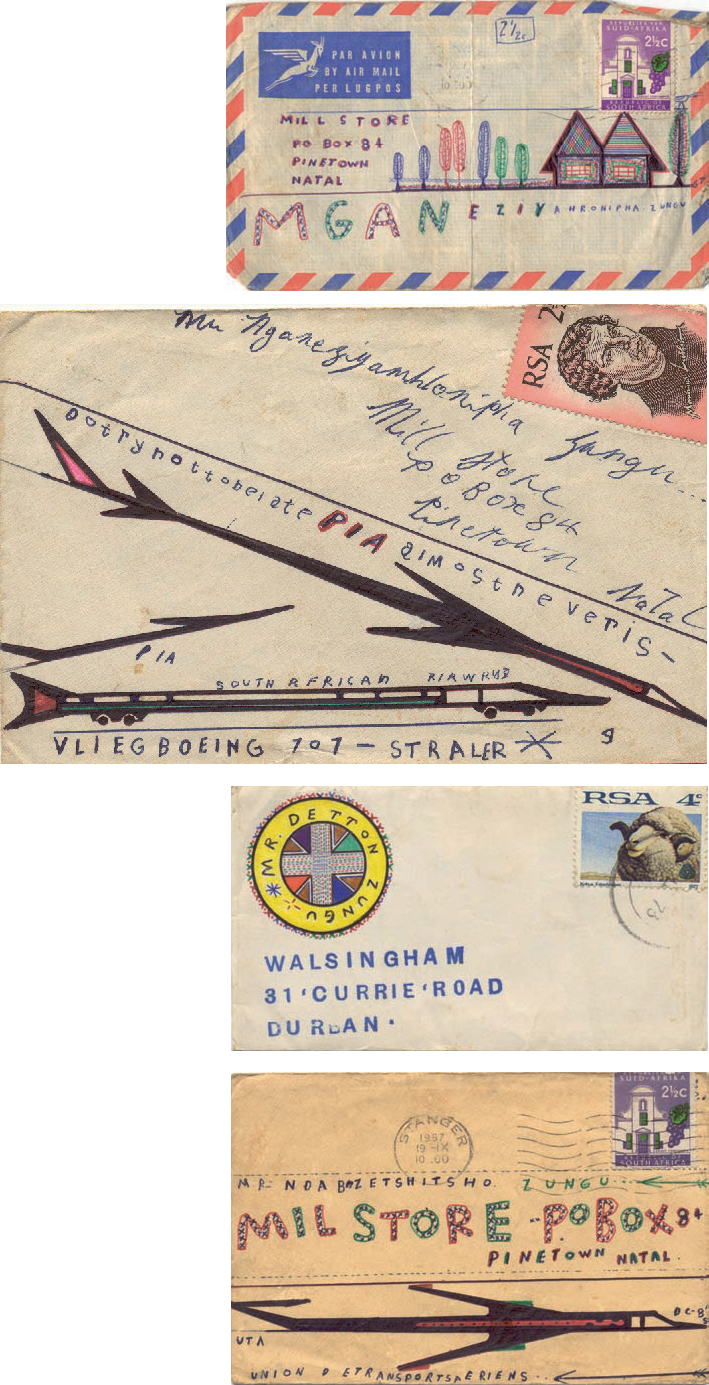In a society where black migrant workers in the construction and mining industries came to the cities to work for months on end, leaving their loved ones at home in the country, letters were the lifeblood of the emotional heart of the nation. Anxiously awaited, often written by someone literate who could write for the migrant worker, these missives would carry important details of daily life back and forth, assurances that the sender was in good health, still longing for the return to home.
So important was the delivery of letters that volunteer postal workers, like Nokukhanya Lutuli, wife of 1960 Nobel Peace prizewinner Albert Lutuli, would walk around her rural home district of Groutville in KwaZulu-Natal about forty miles north of Durban, carrying letters to isolated homes as a community service, letters that would be kept by the receiver and treasured over the years.
Painstakingly decorating the envelopes to enclose such letters became an enterprise for the eighteen-year-old Tito Zungu, son of a farmer in Mapumulo, not far from Groutville. In 1957 Zungu started selling envelopes with carefully hand-drawn, vibrantly colored images of planes to his neighbors, charging a few cents for each, about the price of the postage stamp. Zungu had no formal education but was fascinated by modernity: The ships he had seen as a boy sailing up the coast, the planes that flew overhead, modern buildings.
One envelope went to a passing London collector in 1960, but it was only ten years later, four years after Zungu had left Mapumulo to seek work in Durban as a cook, that he was persuaded to take one of his envelopes to the redoubtable Jo Thorpe, director of the African Art Centre in Durban and a key person in encouraging and promoting local artists through her small gallery store.
That moment marked Zungu’s entry into the art world, and in 1982 Zungu had his first solo exhibition, at the University of Witwatersrand Art Gallery in Johannesburg. Later on he participated in important international group shows like Art from South Africa (Museum of Modern Art, Oxford, 1990) and Incroci del Sud (XLV Venice Biennale, 1993). Zungu had always made drawings beyond his embellished envelopes, using ball point and felt tip pens as his only tools and, later, more permanent artists’ inks. In these larger drawings his compositions were more expansive, combining highly complex renderings of buildings with those of planes, cars, and flowering plants.
Engaging and singular as Zungu’s ships and planes are, it is in his buildings that the artist took his greatest leaps of faith. His fantastical structures float free from the ground, with towers unfettered by structural considerations. Every inch of the building is obsessively covered with meticulously ordered, brilliant patterning, presenting us with the vivid and visionary architecture of Zungu’s imagination. Zungu died in Durban in 2000, leaving behind the rich heritage of his work.

Collection of envelopes and letters 1966–75
Paper, ink, pencil
Dimensions variable: largest envelope 10.2 x 43 cm
Collection: Standard Bank African Art Collection (Wits Art Galleries), Johannesburg
Image courtesy Wits Art Galleries
Photographer: Wayne Oosthuizen
© Wits Art Galleries